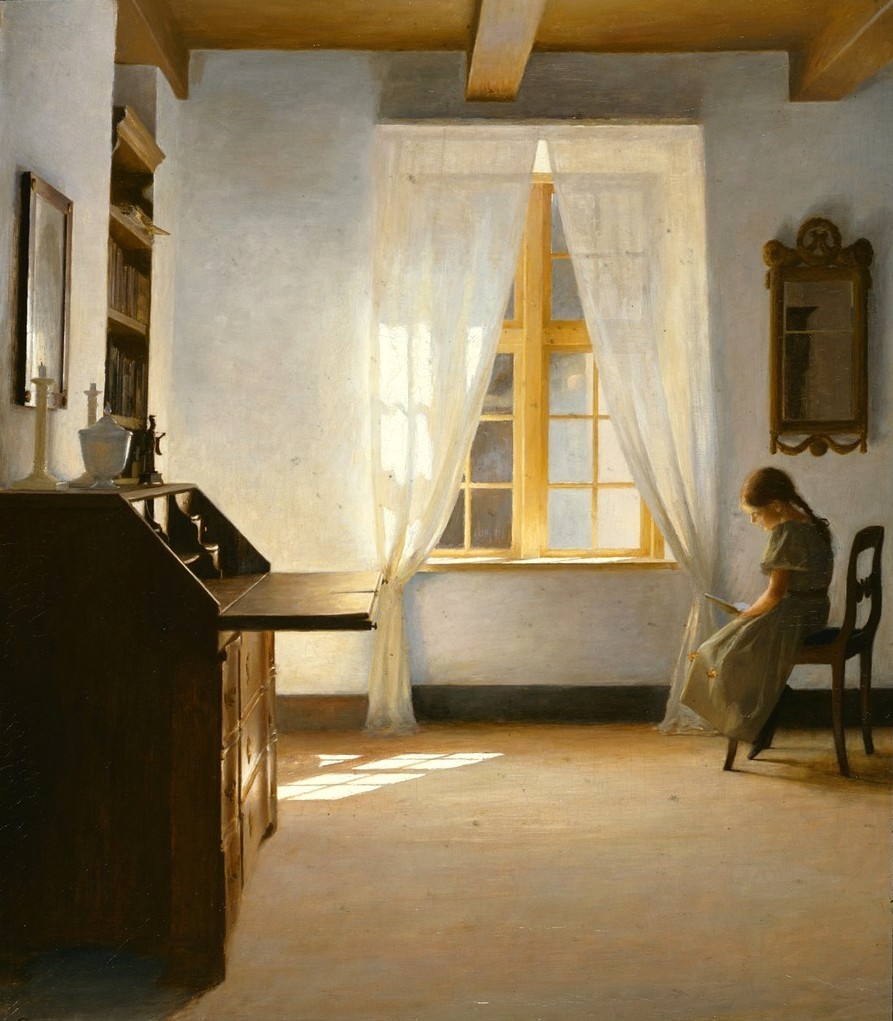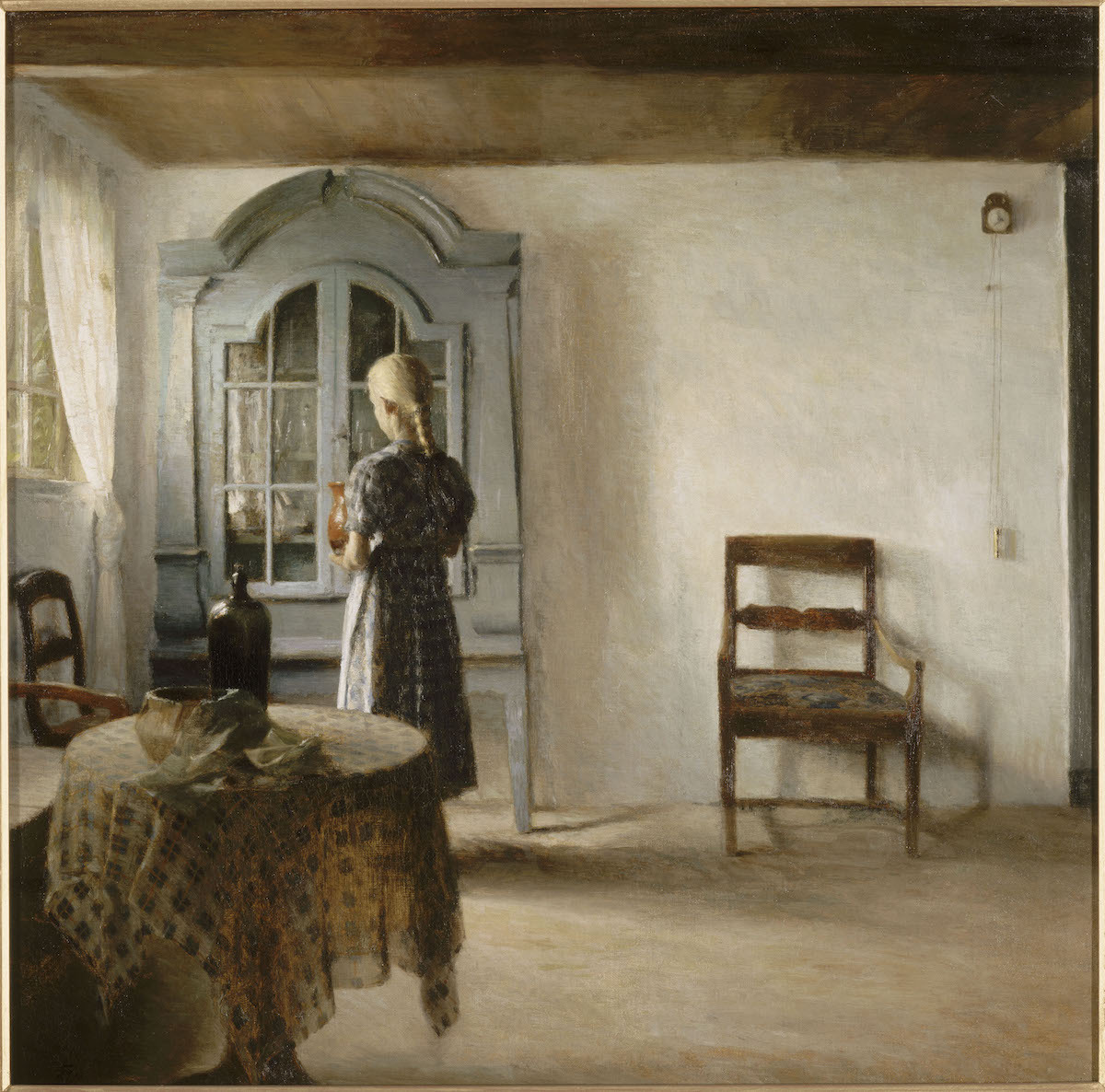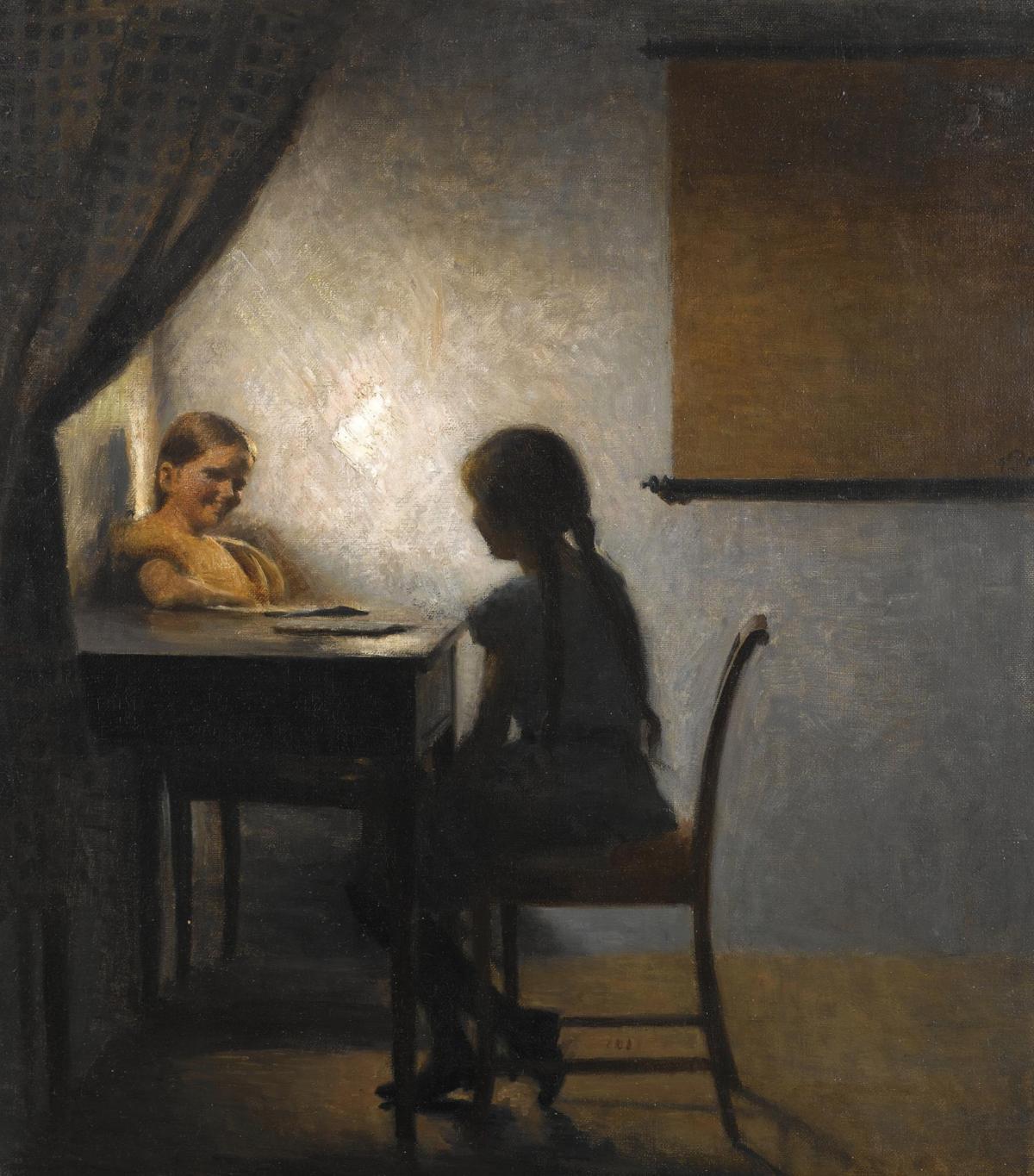I recently wrote about the turn of the century Danish painter Peter Ilsted and his delightful, sunny and cozy interior scenes with girls playing or reading books and I mentioned Knut Hamsun’s novel “Hunger”, well today I want to focus exclusively on Hamsun’s novel and the painting which reminds me of one scene from the novel.
 Peter Vilhelm Ilsted (Danish artist, 1861-1933), Looking Out the Window, 1908
Peter Vilhelm Ilsted (Danish artist, 1861-1933), Looking Out the Window, 1908
In “Looking Out of the Window”, a pretty young girl in a black dress and two long braids is looking out of the window. As usual with these Northern painter such as Hammershoi and Ilsted, the girl’s face is not seen, but still I know that she is pretty because she must be and I want her to be because I see her as the Ylajali from Knut Hamsun’s novel “Hunger”; the sweet-scented, pretty and mysterious girl that the narrator meets one day by chance in the street and later he has a very interesting conversation with her one night. In this painting Ilsted offers a somewhat voyeuristic view of the girl looking out of the window because she is in the other room, and she left the doors behind her open and that’s why we see her through the corridor. If the white doors were closed, the girl would be a mystery and all that would remain on the canvas would be the little table, a painting with shadowy figures and the door. The interior would seem cold and uninviting, but the girl with the braids adds a mysterious touch to it.
What is she looking at? Or should I say, on what strange gentleman are her eyes set? The answer lies in Hamsun novel “Hunger”; written in the first person in the stream of consciousness style, the unnamed narrator is a young aspiring journalist who, poor and hungry, wanders the streets and encounters many things on his way. This is how the novel begins: “It was during the time I wandered about and starved in Christiania: Christiania, this singular city, from which no man departs without carrying away the traces of his sojourn there.” Hungry, half-desperate and half-hopeful in a mad way, with frail nerves, empty stomach and a thin coat, he leaves his attic room in search of….something to fill his day. While on a walk in the beginning of the novel, he sees two ladies walking with their parasols, and accidentally brushes one, turning around to apologise, he sees her pale face and cheeks blushing and she is instantly lovely to him; “I feel myself seized with an odd desire to make this lady afraid; to follow her, and annoy her in some way. I overtake her again, pass her by, turn quickly round, and meet her face-to-face in order to observe her well. I stand and gaze into her eyes, and hit, on the spur of the moment, on a name which I have never heard before–a name with a gliding, nervous sound–Ylajali!”

The mysterious girl whose pale face hidden under the veil cannot leave his mind is named Ylajali and he follows her to the bookstore and then to the house where she apparently lives and here is that part of the novel which reminds me of Ilsted’s painting:
“Outside No. 2, a large four-storeyed house, they turned again before going in. I leant against a lamp-post near the fountain and listened for their footsteps on the stairs. They died away on the second floor.
I advanced from the lamp-post and looked up at the house. Then something odd happened. The curtains above were stirred, and a second after a window opened, a head popped out, and two singular-looking eyes dwelt on me. “Ylajali!” I muttered, half-aloud, and I felt I grew red.
Why does she not call for help, or push over one of these flower-pots and strike me on the head, or send some one down to drive me away? We stand and look into one another’s eyes without moving; it lasts a minute. Thoughts dart between the window and the street, and not a word is spoken. She turns round, I feel a wrench in me, a delicate shock through my senses; I see a shoulder that turns, a back that disappears across the floor. That reluctant turning from the window, the accentuation in that movement of the shoulders was like a nod to me. My blood was sensible of all the delicate, dainty greeting, and I felt all at once rarely glad. Then I wheeled round and went down the street.
I dared not look back, and knew not if she had returned to the window. The more I considered this question the more nervous and restless I became. Probably at this very moment she was standing watching closely all my movements. It is by no means comfortable to know that you are being watched from behind your back. I pulled myself together as well as I could and proceeded on my way; my legs began to jerk under me, my gait became unsteady just because I purposely tried to make it look well. In order to appear at ease and indifferent, I flung my arms about, spat out, and threw my head well back–all without avail, for I continually felt the pursuing eyes on my neck, and a cold shiver ran down my back. At length I escaped down a side street, from which I took the road to Pyle Street to get my pencil.”
Ylajali, what a beautiful and exotic name to my ears! This scene from “Hunger” lingered in my mind for some time after finishing the novel.

Vilhelm Hammershoi, Interior, Strandgade 30, 1901
And just for comparison, here is Vilhelm Hammershoi’s painting with a similar theme, again a lady is looking out the window, her back turned against us, her face hidden, but this version of the same scene doesn’t speak to me as much as Ilsted’s version does. Hammershoi does have a mystery and a certain magic, but this strictness of elements, minimalism, and the palette of greys is painfully oppressive and I just wanna die when I gaze it for a long time.






